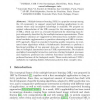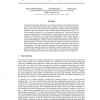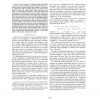97 search results - page 2 / 20 » Learning Condensed Feature Representations from Large Unsupe... |
ECML
2006
Springer
13 years 8 months ago
2006
Springer
Multiple-instance learning (MIL) is a popular concept among the AI community to support supervised learning applications in situations where only incomplete knowledge is available....
NIPS
2007
13 years 6 months ago
2007
Unsupervised learning algorithms aim to discover the structure hidden in the data, and to learn representations that are more suitable as input to a supervised machine than the ra...
IJCNN
2008
IEEE
13 years 11 months ago
2008
IEEE
— Fuzzy Associative Conjuncted Maps (FASCOM) is a fuzzy neural network that represents information by conjuncting fuzzy sets and associates them through a combination of unsuperv...
AAAI
2000
13 years 6 months ago
2000
Due to the large variation and richness of visual inputs, statistical learning gets more and more concerned in the practice of visual processing such as visual tracking and recogn...
ICML
2007
IEEE
14 years 5 months ago
2007
IEEE
We present a new machine learning framework called "self-taught learning" for using unlabeled data in supervised classification tasks. We do not assume that the unlabele...



